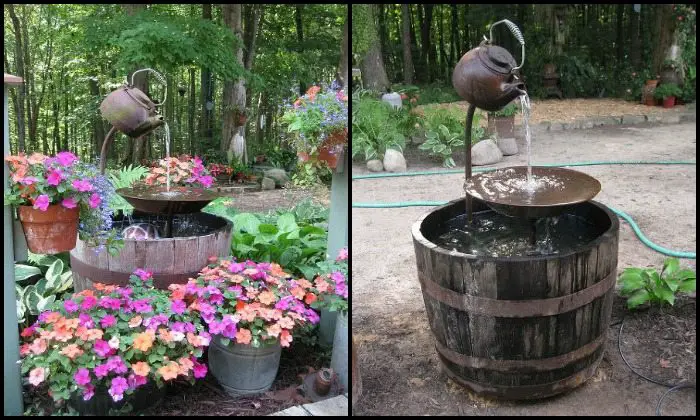Love recycled project ideas? If you do, you’ll surely like this fountain which makes a rustic decor for your garden!
However old your teapot looks, you can definitely use it to make an interesting water feature for your yard! You can even use other old and recycled materials to build your unique fountain.
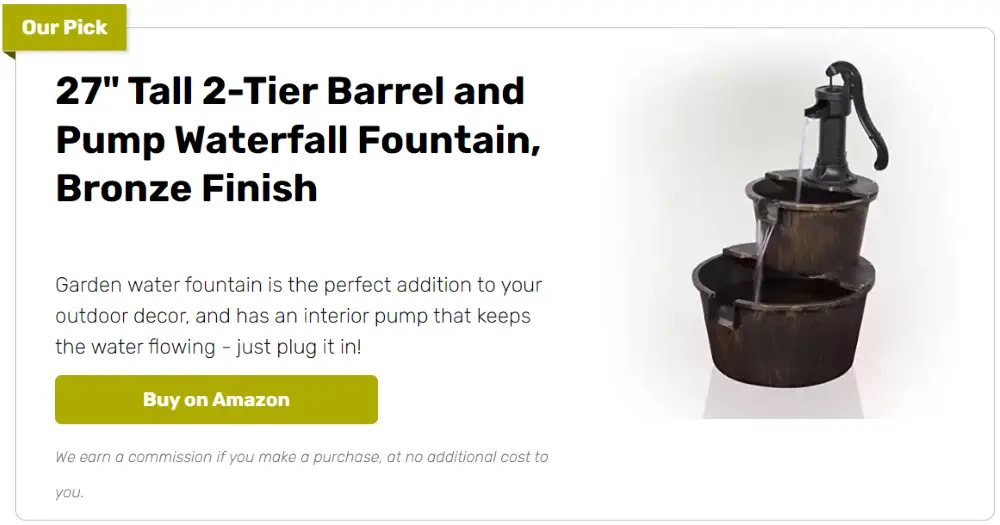
It might look a little difficult but this teapot fountain is easier to put together than it looks!
Want a similar teapot fountain for your garden? You can learn how it’s made by getting the link to a tutorial provided below!
We’ve also collected some teapot fountain inspiration to help you design your own, unique version.
Contents
- 1 Building a Teapot Fountain
- 2 Design Variations and Themes
- 3 Maintenance and Care
- 4 FAQ for DIY Teapot Fountain
- 4.1 What size pump do I need for my teapot fountain?
- 4.2 Can I use any teapot for this fountain?
- 4.3 How do I prevent my teapot fountain from tipping over?
- 4.4 How often should I change the water in my fountain?
- 4.5 Can I add plants to my teapot fountain?
- 4.6 How can I keep mosquitoes away from my fountain?
- 5 Conclusion
Building a Teapot Fountain
Materials
- Concrete Mix
- Old Tea Pot
- Whiskey Barrel
- Fountain Pump
- Tubing
- Small Rocks
Tools
- Drill
Instructions
1. Prepare the Whiskey Barrel
- Step 1.1: Ensure your whiskey barrel is clean and free of debris. If it’s not waterproof, apply a waterproof sealant inside and let it dry according to the product’s instructions.
- Step 1.2: Drill a hole near the bottom of the barrel, large enough for the power cord of the fountain pump to pass through.
2. Set Up the Fountain Pump
- Step 2.1: Place the fountain pump inside the whiskey barrel. Thread the pump’s power cord through the hole you drilled, ensuring it reaches the power source.
- Step 2.2: Attach one end of the tubing to the pump. The tubing will transport water from the pump to the teapot, creating the fountain effect.
3. Prepare the Teapot
- Step 3.1: If your teapot has a lid, secure it with waterproof silicone to prevent water from splashing out.
- Step 3.2: Drill a hole in the bottom of the teapot large enough for the other end of the tubing to fit through snugly. Be careful to drill slowly to avoid cracking the teapot.
4. Install the Teapot
- Step 4.1: Feed the free end of the tubing through the hole in the bottom of the teapot.
- Step 4.2: Position the teapot inside the barrel, ensuring it’s stable. You can use concrete mix to create a base for the teapot if needed. If you’re using concrete, mix it according to the package instructions, place the teapot in the desired position, and pour the concrete around the base of the teapot. Allow it to cure as directed.
5. Add Finishing Touches
- Step 5.1: Fill the whiskey barrel with water until the pump is fully submerged.
- Step 5.2: Spread small rocks around the base of the teapot inside the barrel for aesthetic purposes and to help conceal the pump and tubing.
- Step 5.3: Plug in the pump to test the fountain. Adjust the flow rate on the pump if necessary to achieve the desired water flow from the teapot.
6. Final Adjustments
- Step 6.1: Once you’re satisfied with the water flow, make any necessary adjustments to the position of the teapot or rocks to perfect the fountain’s appearance.
- Step 6.2: Add additional decorations around the whiskey barrel if desired, such as plants, stones, or other garden ornaments to integrate the fountain seamlessly into your garden’s landscape.
Design Variations and Themes
You can further enhance the look of your teapot fountain by incorporating various designs and themes around it. These designs can further boost the look of your outdoor space by adding that small, detailed charm.
Classic Elegance
For those who appreciate the timeless beauty of traditional garden elements, a classic-themed teapot fountain is a perfect choice. Opt for teapots with vintage designs, such as floral patterns or ceramic glazes, and pair them with a simple, rustic whiskey barrel. To enhance the elegance, consider surrounding the fountain with classic garden flowers like roses or peonies, creating a serene and sophisticated ambiance.
Modern Minimalism
If your garden embodies a contemporary vibe, a minimalist teapot fountain can add a touch of sophistication without overwhelming the space. Focus on clean lines and simplicity by choosing a sleek, modern teapot and a geometric basin. Materials such as polished stone or stainless steel can complement the minimalist theme. At the same time, a monochromatic color scheme keeps the focus on the fountain’s form and the gentle flow of water.
Whimsical Wonderland
For a garden that serves as a retreat into a fantastical world, a whimsical teapot fountain can be the centerpiece that brings your imaginative vision to life. Combine brightly colored teapots, playful patterns, and unexpected elements like fairy lights or small figurines to create a sense of wonder. This theme is particularly suited for gardens that aim to be a joyful escape for both children and adults alike.
Rustic Retreat
Embrace the rustic charm of country living with a teapot fountain that features natural materials and a laid-back style. Use an aged metal or earthenware teapot and pair it with a wooden barrel or a stone basin. Incorporating elements like moss, weathered wood, and river rocks can further enhance the rustic feel, making your fountain appear as if it has been a part of the landscape for years.
Zen Sanctuary
For those seeking a tranquil haven within their garden, a Zen-themed teapot fountain can create a peaceful and meditative space. Choose a simple, elegantly shaped teapot and set it within a smooth pebbles or sand basin. Bamboo elements, minimalist plantings like moss or ferns, and the gentle sound of trickling water can contribute to a soothing atmosphere that invites relaxation and contemplation.
Each design variation and theme offers a unique way to incorporate a teapot fountain into your garden, transforming your outdoor space into an area that reflects your style and enhances your home’s overall appeal.
Click on any image to start the lightbox display. Use your Esc key to close the lightbox.
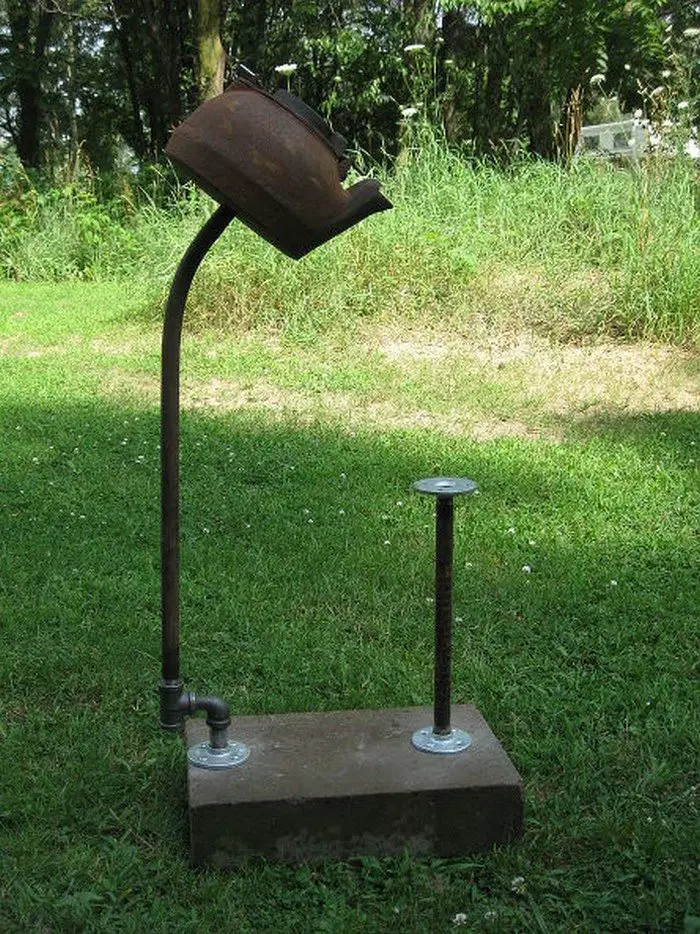
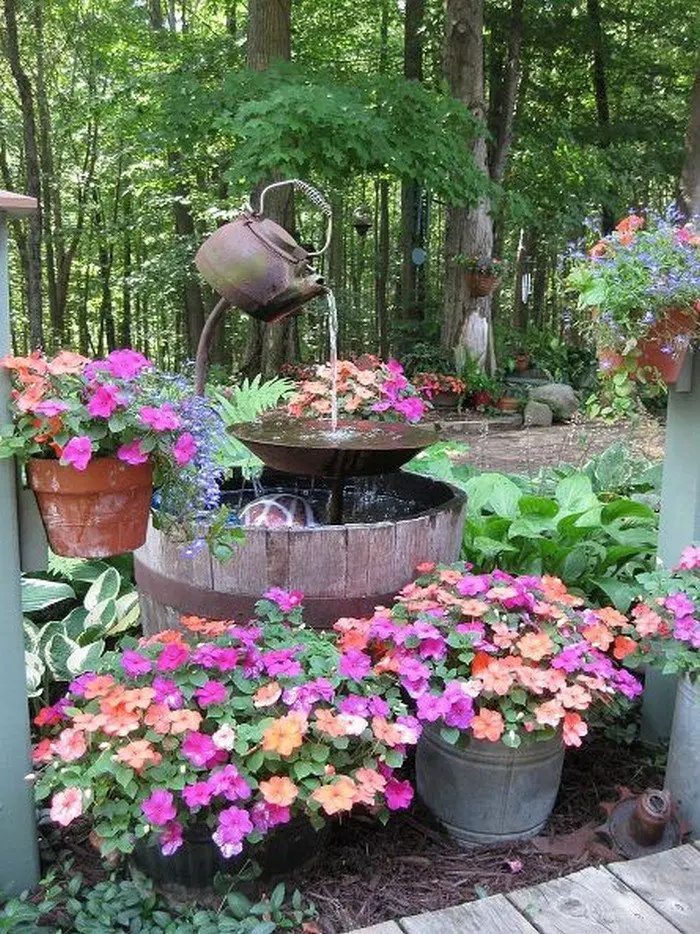
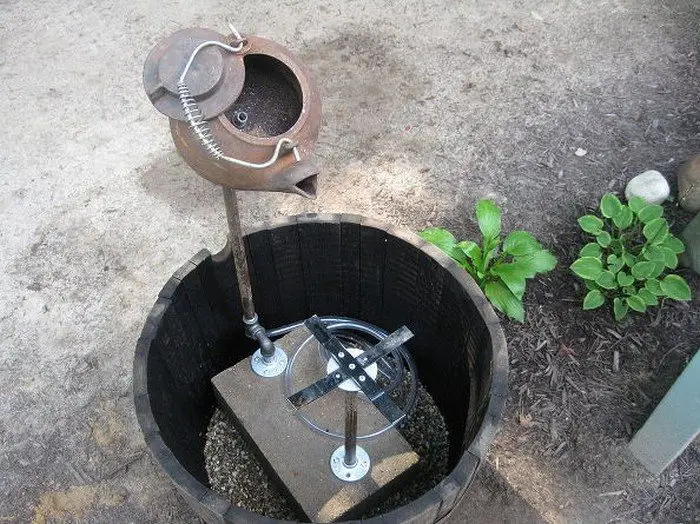


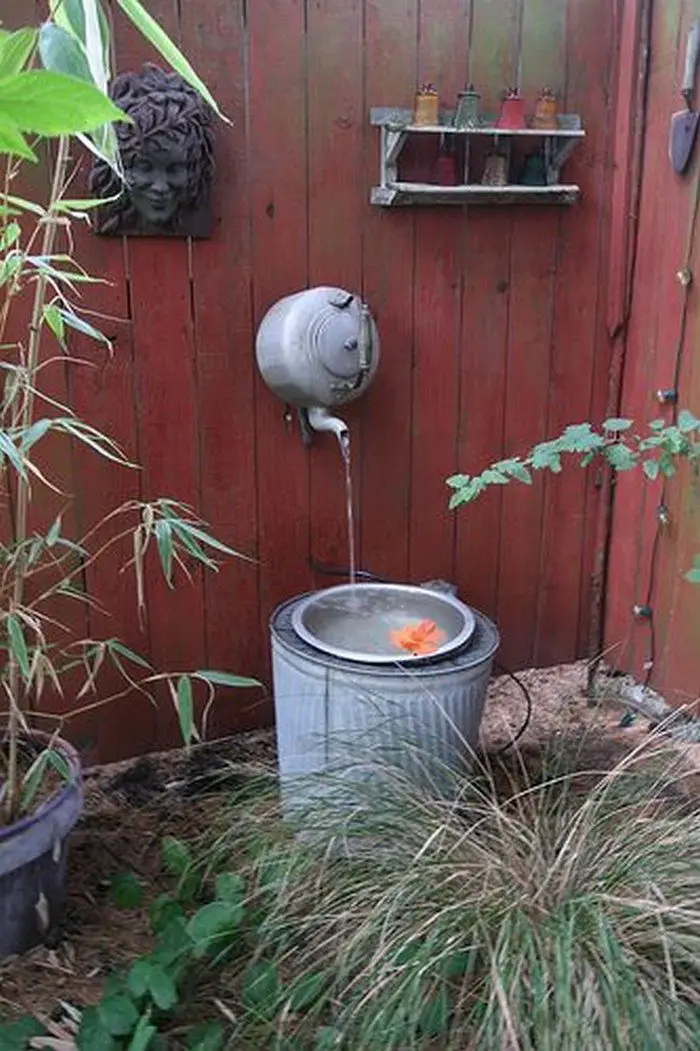
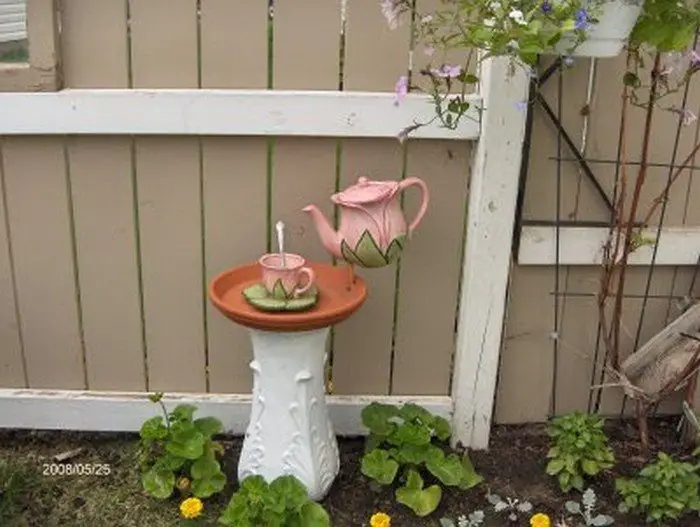

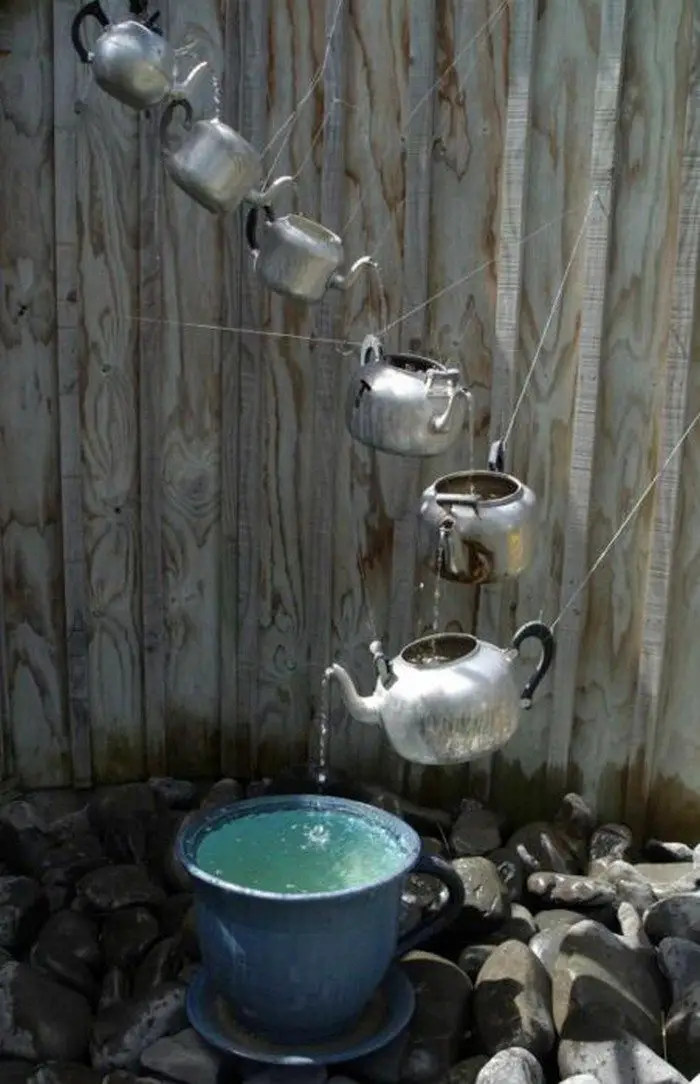

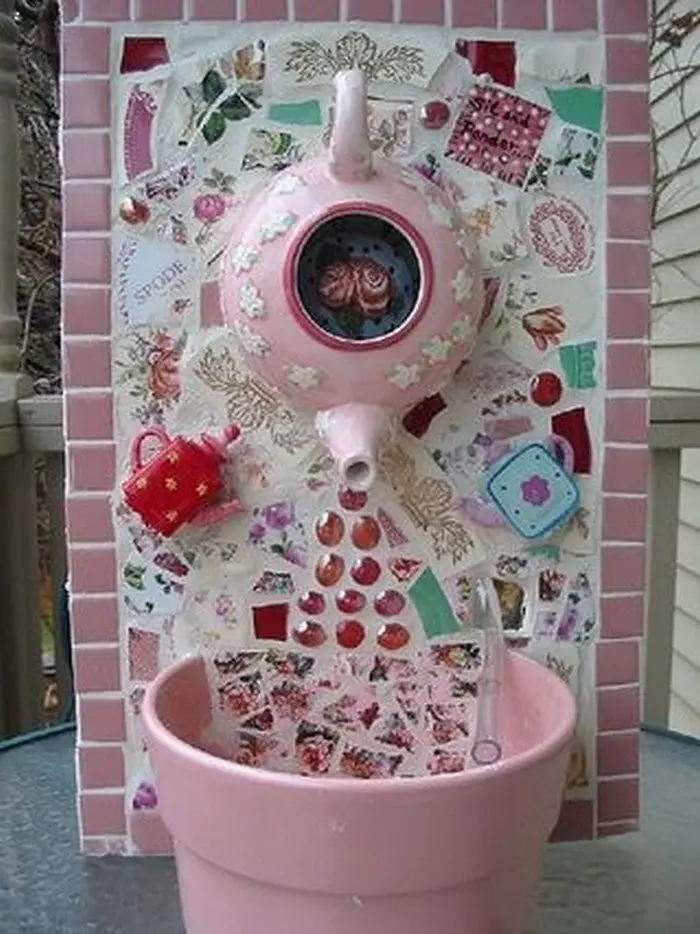
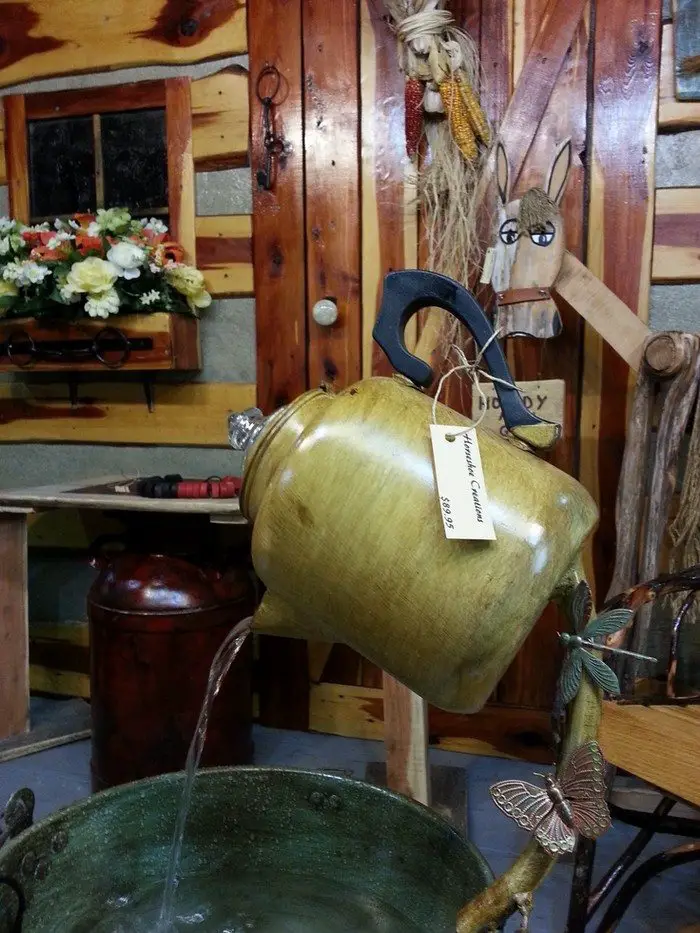
Maintenance and Care
Maintaining and caring for your teapot fountain is essential to ensure its longevity, aesthetic appeal, and proper functioning. A well-maintained fountain can be the centerpiece of your garden for years to come, offering a serene and delightful water feature that enhances the tranquility of your outdoor space. Regular maintenance not only preserves the beauty of your teapot fountain but also prevents potential issues that could arise from neglect.
Here are some essential tips and practices for keeping your teapot fountain in top condition.
Regular Cleaning
- Frequency and Procedure: Clean your teapot fountain every two to three months, or more often if it’s exposed to a lot of debris or outdoor elements. Start by turning off the pump and draining the water. Remove any visible debris, such as leaves or twigs, from the water basin and the teapot. Use a soft brush and a gentle, environmentally friendly cleaner to scrub the surfaces of the teapot and the basin, focusing on areas with algae growth or mineral deposits.
- Pump Care: The pump is the heart of your teapot fountain, and keeping it clean is crucial for smooth operation. Detach the pump according to the manufacturer’s instructions and remove any dirt or debris clogging it. Soak the pump in a vinegar solution if there are mineral deposits, then rinse thoroughly before reinstalling.
- Softening Mineral Deposits: For stubborn mineral deposits common in areas with hard water, applying a solution of white vinegar and water can help soften these deposits before scrubbing. Allow the solution to sit on the affected areas for several minutes, then gently scrub with a soft brush. This method is especially effective on ceramic and metal teapots, helping to maintain their finish.
- Eco-Friendly Cleansers: Utilize eco-friendly cleansers that are designed for use in water features. These cleansers reduce the risk of harming local wildlife or plants in your garden. Look for products that specifically state they are safe for bird baths and fountains.
- Use of Protective Covers: When the fountain is not in use, especially during periods of heavy pollen or in the fall when leaves are abundant, consider using a breathable, waterproof cover to protect it. This can significantly reduce the amount of debris and dirt accumulating in the water and fountain surfaces, making your regular cleaning routine easier.
Water Quality Management
- Algae Prevention: Algae growth can be common in outdoor water features. To minimize algae, ensure your teapot fountain is positioned where it receives a balance of sunlight and shade; excessive sunlight can promote algae growth. Using an algaecide safe for wildlife can also help keep algae at bay, especially during warmer months.
- Water Treatment: Regularly treat the water with safe, fountain-specific products to maintain its clarity and prevent the buildup of harmful bacteria. Ensure the products you choose are pet and wildlife-friendly if animals visit your garden.
- Natural Water Treatments: Explore the use of natural water treatments, such as barley straw, which is known for its ability to naturally combat algae growth without harming the environment. Barley straw does not kill existing algae but prevents the growth of new algae cells. It’s a slow-acting, long-term treatment method that becomes more effective over time.
- Water Circulation: Ensure that your fountain’s pump is correctly sized for the volume of your teapot fountain to maintain adequate water circulation. Good circulation is crucial for oxygenating the water, which helps prevent algae growth and keeps the water clear. It also ensures that any water treatment products are evenly distributed throughout the fountain.
- Monitoring Water Levels: Keep an eye on the water level in your fountain, especially during hot or windy weather, as evaporation can lower water levels faster than you might expect. Low water levels can cause the pump to work harder, potentially shortening its lifespan. Adding water regularly to maintain the correct level ensures the pump operates efficiently and reduces wear and tear.
- Periodic Water Changes: While regular top-ups are necessary, completely changing the water in your fountain periodically can significantly improve water quality. Over time, even with treatment, water can accumulate minerals, debris, and other materials that can affect the pump’s performance and clarity.
Seasonal Care
- Winterizing: If you live in an area where temperatures drop below freezing, it’s important to winterize your teapot fountain to prevent damage. Before the first freeze, drain all water from the fountain and pump, clean thoroughly, and store the pump indoors. Cover the fountain or move it to a protected area if possible to prevent frost damage.
- Spring Setup: When setting up your teapot fountain for the warmer months, check for any damage that may have occurred during the winter. Clean the fountain and pump thoroughly, reassemble, and fill with fresh water. Test the pump to ensure it’s working correctly before enjoying your fountain for another season.
- Autumn Leaf Guard: Besides using a protective cover, consider installing a mesh screen or leaf guard over your fountain during autumn to prevent leaves and debris from clogging the pump and water basin. This preventive measure can significantly reduce cleaning efforts and maintain water quality.
- Insulation Against Frost: Consider insulating your fountain for regions experiencing mild winters where complete storage isn’t necessary. Wrapping the teapot and any exposed piping with burlap or a similar frost-resistant material can prevent cracking due to freezing temperatures.
- Solar Pump Considerations: If your teapot fountain uses a solar pump, remove and store it indoors during winter. This protects the pump from damage and ensures its efficiency and longevity. Remember to clean the solar panels before storage and again before reinstalling them in the spring.
- Spring Inspection Checklist: Develop a comprehensive spring inspection checklist that includes checking for any frost damage, ensuring the stability of the fountain’s base, and verifying the integrity of all connections and tubing. This proactive approach can help you catch and address minor issues before they escalate.
Inspecting for Repairs
- Regular Checks: Periodically inspect your teapot fountain for any signs of wear and tear, such as cracks, leaks, or malfunctioning parts. Addressing these issues promptly can prevent more significant problems down the line.
- Professional Help: For complex issues related to the pump or electrical components, consider seeking professional assistance to ensure repairs are conducted safely and effectively.
- Listening for Pump Irregularities: Pay attention to the sound of your fountain’s pump. Changes in noise level or rhythm can indicate a problem, such as a blockage or a malfunctioning motor. Early detection of these changes can prevent more significant damage.
- Sealant and Waterproofing Check: Regularly inspect the sealant around your teapot and any areas where materials meet or where water is intended to flow. If you notice cracks or deterioration in the sealant, reapply a waterproof, non-toxic sealant to prevent leaks and water loss.
- Monitoring for Algae and Limescale Buildup: Even with regular cleaning, keep an eye out for algae and limescale buildup, as these can indicate water quality issues or insufficient circulation. Early removal and adjustment of water treatment can prevent these buildups from affecting the pump’s efficiency and the overall aesthetic of your fountain.
- Visual Inspection for Wear and Tear: Regularly conduct a thorough visual inspection of your fountain, paying close attention to the teapot, any decorative elements, and the water basin for signs of wear, tear, or weathering. Materials like ceramic, metal, and stone can show age differently, so knowing what to look for can help you preemptively address issues like erosion or discoloration.
Adhering to these maintenance and care guidelines will help extend the life of your teapot fountain, ensuring it remains a beautiful and functional feature in your garden. Regular attention and care allow you to enjoy your teapot fountain’s soothing sounds and sights without the hassle of unexpected repairs or replacements.
FAQ for DIY Teapot Fountain
What size pump do I need for my teapot fountain?
The pump size you need depends on the height and width of your teapot fountain. For most small to medium-sized fountains, a pump with a flow rate of 50 to 200 gallons per hour (GPH) should be sufficient. Always check the pump’s specifications to ensure it meets the requirements for your specific fountain setup.
Can I use any teapot for this fountain?
Yes, you can use any teapot, but choosing one made of durable material like ceramic, porcelain, or metal is best. Ensure it has a wide spout to allow for a smooth water flow. If it’s a valuable or sentimental item, consider the potential for damage before drilling into it.
How do I prevent my teapot fountain from tipping over?
Ensure the teapot is securely positioned. If using concrete to anchor it, ensure the base is level and the teapot is supported until the concrete sets. Alternatively, you can place large stones or bricks around the teapot inside the barrel to add stability.
How often should I change the water in my fountain?
Changing the water every 1 to 2 months is recommended, or more frequently if the water becomes dirty or cloudy. Regular water changes help prevent algae growth and keep the pump running smoothly.
Can I add plants to my teapot fountain?
Yes, adding plants can enhance the beauty of your fountain. Consider aquatic or moisture-loving plants that can thrive in or around water. Ensure any plants inside the barrel don’t obstruct the pump or the water flow.
How can I keep mosquitoes away from my fountain?
To deter mosquitoes, ensure the water is moving and not stagnant, as mosquitoes prefer still water for breeding. You can also add a mosquito repellent product designed for water features, ensuring it’s safe for pets and wildlife if they can access your garden.
Conclusion
Crafting a teapot fountain is a rewarding DIY project and a unique addition to any garden, blending creativity with the soothing presence of water. This guide provides the steps and tips to ensure success, encouraging even novice DIYers to embark on this enchanting endeavor. Grab the opportunity to transform simple materials into a captivating focal point that enhances the beauty and tranquility of your outdoor space.
Read our garden cloche project next for more ways to enhance your garden!

